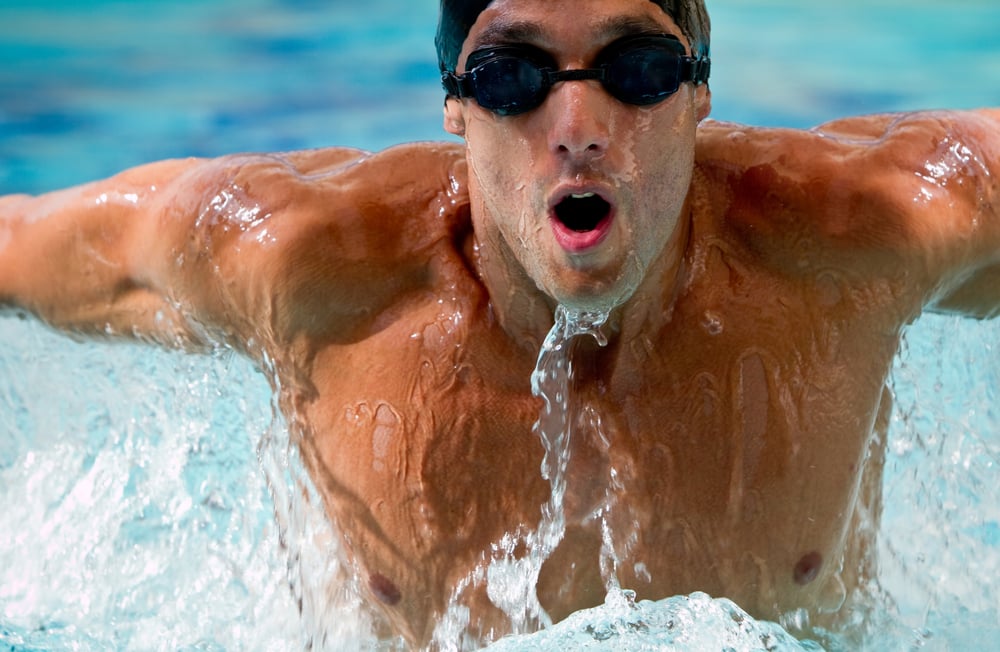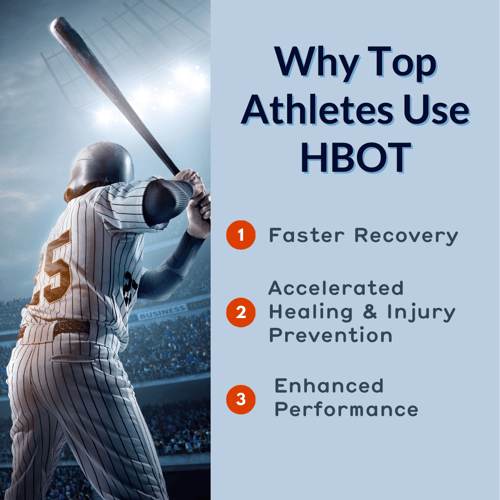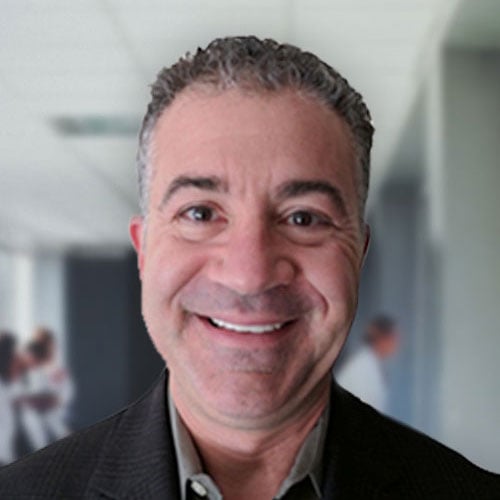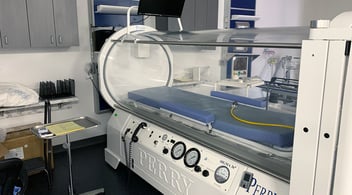6 Reasons Top Athletes Use Hyperbaric Oxygen Therapy

THIS ARTICLE AT A GLANCE:
Hyperbaric Oxygen Therapy (HBOT) is gaining popularity among top athletes for faster recovery, improved endurance, reduced inflammation, and cognitive support. By boosting oxygen in the body, HBOT helps enhance athletic performance and accelerates the body’s natural healing processes after injury or intense training.
Hyperbaric oxygen therapy (HBOT) is a treatment that involves breathing pure oxygen in a pressurized chamber. While it has been used for decades to treat a range of medical conditions, including decompression sickness, carbon monoxide poisoning, and non-healing wounds, it has gained popularity in recent years as a performance-enhancing tool for athletes.
Many top athletes, including NFL quarterback Tom Brady, NBA star LeBron James, and MMA fighter Georges St-Pierre, have reported using HBOT to improve their recovery and performance. The HMS team regularly treats professional athletes (MLB, NFL, NBA, NHL, and the ATP tour), and fitness enthusiasts using special protocols to help muscle recovery and enhance performance.
So why are top athletes using HBOT, and what does the science say about its benefits?
Why Top Athletes Use HBOT

1. Faster Recovery
Hyperbaric oxygen therapy is used by athletes to enhance recovery after intense physical exertion or injuries.
One of the key benefits of HBOT is that it can increase the amount of oxygen that reaches the body's tissues. This happens because the increased pressure in the chamber allows the oxygen to dissolve into the blood plasma and reach areas that may be poorly perfused or oxygen-deprived. This can help speed up the recovery process after an injury or intense workout and improve overall performance.
A 2019 study showed that HBOT significantly reduced muscular enzyme levels and improved pain intensity, being highly beneficial for competitive athletes.
2. Accelerated Healing from Injury
HBOT can help to reduce the amount of time that athletes need to spend off the field or court, which can have large opportunity or financial costs. Through the anti-inflammatory effects HBOT has been shown to have, which could help to reduce the risk of injuries and improve recovery time. By accelerating the healing process and reducing inflammation, HBOT can help athletes to get back to their sport faster, and with fewer limitations.
HBOT accelerates healing by increasing oxygenation in the body which can help to reduce inflammation and promote tissue regeneration. This is especially important for athletes who are recovering from injuries, as inflammation is a natural part of the healing process but can also cause further tissue damage if left unchecked. In one study, athletes reported a quicker improvement of their symptoms when using HBOT.
HBOT can also help stimulate the growth of new blood vessels in injured areas, which can increase the supply of oxygen and nutrients to the affected tissues, which can help speed up the healing process.
HBOT TO SUPPORT HEALING FROM CONCUSSIONS
Professional athletes are increasingly receiving HBOT to help them recover from many types of injuries, even concussions. Joe Namath, who played for the New York Jets for the majority of his NFL career, suffered from multiple head injuries as an NFL quarterback. As a result, he dealt with memory loss, focus issues, and feelings of anxiousness and irritability before trying HBOT. Now, not only have his symptoms subsided, but he has become an advocate for HBOT and was recently a keynote speaker at the Long Island Head Injury Association's Celebrity Sports Forum.
Bill Romanowski, a retired linebacker, also uses HBOT to help address the lasting results of at least 20 concussions he suffered from during his 16 years in the NFL. Dr. Scott Sherr, HMS Medical Advisor and Head of Innovation and Protocol Development, treated Romanowski at a hyperbaric facility in California for his condition, showing very positive results.
3. Enhanced Athletic Performance
In addition to its benefits for injury recovery, HBOT can also help to enhance athletic performance. By increasing the amount of oxygen that reaches the body's tissues, HBOT can improve aerobic capacity and endurance, which can help athletes to perform better during training and competition.
A 2022 study evaluated the effects of hyperbaric oxygen therapy on mitochondrial respiration and physical performance in middle-aged athletes. The use of hyperbaric oxygen enhanced their physical performance including their maximal oxygen capacity. A study involving young soccer players found that after three weeks of hyperbaric oxygen therapy they had an improvement in performance endurance.
4. Reduce Negative Effects of Chronically Elevated Cytokines
In recent years, researchers have been investigating the concept of chronic cytokines in athletes.
Cytokines are small proteins that play an essential role in the body's immune response. They are involved in regulating inflammation and the response to infection, injury, or stress. However, in some cases, an overactive immune response can lead to a persistent elevated cytokine levels, which can cause significant damage to the body's tissues and organs.
Chronic cytokine elevation refers to a low-grade, persistent state of inflammation that can occur in athletes who engage in intense physical activity regularly. This condition is thought to be caused by the repetitive stress and damage to muscles, joints, and tissues that occurs during training and competition. This persistent state of inflammation can lead to a range of negative effects on the body, including reduced muscle function, increased risk of injury, and impaired recovery from injuries. It has also been linked to various health problems, including cardiovascular disease, insulin resistance, and chronic pain.
One way that athletes may mitigate the effects of chronic cytokine elevation is through hyperbaric oxygen therapy (HBOT). HBOT has been shown to reduce inflammation and promote tissue regeneration, which could help to counteract the effects of the cytokines. In an animal study, HBOT was found to reduce inflammation and promote muscle regeneration in muscle injuries In another study on patients with chronic musculoskeletal pain, HBOT was found to reduce pain and improve function.
While more research is needed to fully understand the relationship between chronic cytokine elevation and athletes, the condition can have negative effects on athletic performance and overall health. Athletes may be able to lessen these effects through HBOT or other treatments aimed at reducing inflammation and promoting tissue regeneration. It is important, however, for athletes to work with a trained medical professional and to follow appropriate safety guidelines when using these treatments.
5. Decreased Inflammation
Injury prevention is another area where HBOT has shown promise. By reducing inflammation and promoting tissue regeneration, HBOT can help prevent injuries from occurring in the first place.
A study published in Scientific Reports found that HBOT could reduce inflammation and improve muscle regeneration in animals with induced muscle injuries. While more research is needed to confirm these findings in humans, they suggest that HBOT could be a useful tool for athletes looking to speed up their recovery and reduce their risk of injury.6. Improved Mitochondrial Function
Mitochondria are known as the powerhouses of the cell, producing most of the energy needed by the body's cells to function. They play a crucial role in athletic performance, as they are essential for muscle contraction and aerobic metabolism.
Research has shown that hyperbaric oxygen therapy (HBOT) can improve mitochondrial function in athletes.
Studies have shown that HBOT can increase the production of reactive oxygen species (ROS) in the mitochondria, which can stimulate mitochondrial biogenesis, the process by which new mitochondria are produced in the body. This can lead to improved mitochondrial function and increased energy production in the body's cells.
HBOT for Athletic Recovery at HMS
When treating professional athletes, we commonly use a combination of Hyperbaric Oxygen Therapy and Platelet Rich Plasma injections to speed up healing.
In conclusion, hyperbaric oxygen therapy (HBOT) has shown promising results in enhancing and accelerating the healing of athletes from various injuries, as well as improving athletic performance through its effects on mitochondrial function, oxygen delivery, inflammation reduction, and tissue repair and regeneration. HBOT has been used in acute injury, injury prevention, chronic injury, and performance optimization. While more research is needed to fully understand the mechanisms underlying the effects of HBOT on athletic performance, the existing evidence suggests that it can be a useful tool for athletes looking to improve their performance and recovery. As with any medical treatment, it is important for athletes to work with a trained medical professional and follow appropriate safety guidelines when using HBOT.
Types of Athletes We Treat
At Hyperbaric Medical Solutions, we have had the privilege of treating a diverse range of athletes, from professionals to amateurs. Our clientele includes professional MMA fighters, UFC competitors, and Jiu-Jitsu practitioners. We've also worked with professional baseball players, tennis athletes, marathon runners, and football players. Additionally, we extend our services to high school and college athletes, catering to a broad spectrum of athletic needs and levels.
The reasons behind seeking treatment vary, from recovering from concussions or injuries to simply striving for enhanced performance. Below, we present several recent case studies highlighting the athletes we've had the privilege of serving.
Case Studies Featuring Athletes We've Treated:
- Case Study: Young Male Overcomes Traumatic Brain Injuries from Sports
- Case Study: College Athlete Recovers from Post-Concussion Symptoms
- Case Study: A Professional UFC Fighter's Journey to Peak Performance
- Case Study: Professional BJJ Fighter Battles Back from a Torn Meniscus with PRP + HBOT
- Case Study: Athletes Torn Meniscus Healed with PRP, without Surgery
HMS Locations
Find an HMS location near you.
New York
Woodbury, NY
(516) 757-0716
Learn MoreNew York
Manhattan
(646) 760-3474
Learn MoreFlorida
Fort Lauderdale
(954) 507-3913
Learn MoreFlorida
Miami
786-550-1975
Learn MoreMassachusetts
Randolph
(781) 961-7887
Learn More
Written by Alan Katz, MD, FUHM, FACEP, FAAEM
Dr. Alan Katz, National Medical Director of Hyperbaric Medical Solutions (HMS), is double board certified in Emergency Medicine and Hyperbaric Medicine. He directs clinical operations, as well as education and research initiatives for HMS, particularly in exploring the use of hyperbaric oxygen therapy....
Read More


